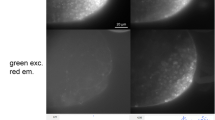Abstract
Human chromosome spreads were stained with 3H-quinacrine and their fluorescence observed. The exact location of specific spreads on each slide was noted and photographs taken. Autoradiographs were then prepared so that the quinacrine fluorescence of any specific chromosome could be compared directly with the distribution of grains over the same chromosome on the autoradiograph. The Y chromosome fluoresced much more intensely than any of the other chromosomes, but there were no more grains over the Y chromosome than over the other chromosomes. Therefore the enhanced fluorescence of the human Y chromosome is not due to an increased binding of quinacrine.
Similar content being viewed by others
References
Caspersson, T., Zech, L., Johansson, C.: Differential binding of alkylating fluorochromes in human chromosomes. Exp. Cell Res. 60, 315–319 (1970)
Chapelle, A. de la, Schröder, J., Selander, R.: In situ localisation and characterisation of different classes of chromosomal DNA: Acridine orange and quinacrine mustard fluorescence. Chromosoma (Berl.) 40, 347–360 (1973)
Evans, H. J., Buckland, R. A., Pardue, M. L.: Location of the genes coding for 18S and 28S ribosomal RNA in the human genome. Chromosoma (Berl.) 48, 405–426 (1974)
Gottesfeld, J. M., Bonner, J., Radda, G. K., Walker, I. O.: Biophysical studies on the mechanism of quinacrine staining of chromosomes. Biochemistry 13, 2937–2945 (1974)
Miller, O. J., Schnedl, W., Allen, J., Erlanger, B. F.: 5-Methylcytosine localised in mammalian constitutive heterochromatin. Nature (Lond.) 251, 636–637 (1974)
Pachmann, U., Rigler, R.: Quantum yield of acridines interacting with DNA of defined base sequence. A basis for the explanation of acridine bands in chromosomes. Exp. Cell Res. 72, 602–608 (1972)
Paris Conference 1971: Standardisation in human cytogenetics. New York: The National Foundation 1972
Schnedl, W.: The karyotype of the mouse. Chromosoma (Berl.) 35, 111–116 (1971)
Weisblum, B.: Fluorescent probes of chromosomal DNA structure; three classes of acridines. Cold Spr. Harb. Symp. quant. Biol. 38, 441–449 (1973)
Weisblum, B., de Haseth, P. L.: Quinacrine, a chromosome stain specific for deoxyadenylatedeoxythymidylate-rich regions in DNA. Proc. nat. Acad. Sci. (Wash.) 69, 629–632 (1972)
Author information
Authors and Affiliations
Rights and permissions
About this article
Cite this article
Hatfield, J.M.R., Peden, K.W.C. & West, R.M. Binding of quinacrine to the human Y chromosome. Chromosoma 52, 67–71 (1975). https://doi.org/10.1007/BF00285790
Received:
Accepted:
Issue Date:
DOI: https://doi.org/10.1007/BF00285790




